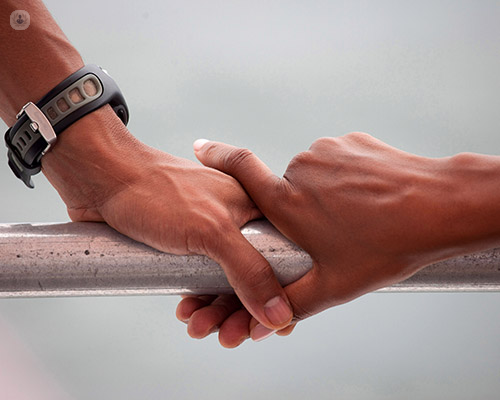


What is a hand fracture?
A hand fracture, or broken hand, affects one or more of the bones found in the hand. It occurs when the bone(s) break or crack, often as the result of a fall or through sporting activity. A fracture can be simple, involving only a few fragments of bone, or it can be more complex, involving multiple fragments. Fractures can also be closed, meaning there is no break in the skin, or compound (open), where the skin breaks over the fracture.

What causes fractures?
A blow to the wrist or hand, or an injury crushing the hand can result in fractures and breaks in the bones. Fractures are commonly caused by falls, particularly onto an outstretched hand when trying to break the fall. Contact sports can be a cause of such falls, along with sports like skiing, skating, or snowboarding. Fractures can also be caused by trauma to the hand in high-impact situations like a car crash.
What are the symptoms of a fracture?
A broken wrist or hand can cause the following symptoms, which are usually immediate, and require urgent medical attention:
- Swelling
- Tenderness to the touch
- Severe pain which gets worse when gripping an object or when moving the wrist/hand
- Deformity in the wrist or fingers
- Stiffness or complete inability to move fingers
- Bruising
- Numbness
Risk factors for fractures
Playing contact sports or engaging in high-impact activities can increase your risk of breaking a bone. Some particularly high-risk sports include hockey, rugby, football, skating, trampolining, horseback riding, skiing, and skateboarding. It is impossible to prevent fractures, but you can try to protect your bones as best as you can by doing strengthening exercises, wearing a wrist guard, and avoiding situations which might cause a fall, such as walking on slippery surfaces.
What is the treatment?
To diagnose a broken or fractured hand, X-rays are usually taken, along with a physical exam done by a healthcare professional. There are various methods of treating a broken hand, and the treatment depends on the severity of the fracture. Often the doctor first moves and manipulates the pieces of bone and fragments back into their correct position, frequently done under anaesthetic. Treatment can then consist of:
- Medications: in order to help reduce pain or, in the case of an open fracture, help the wound to heal, pain medication or antibiotics may be prescribed
- Restricting movement: in order to help the bones heal, the affected area must have movement restricted, usually meaning a cast or splint is placed
- Surgery: some patients may need to have their bones held in place by screws, rods, and plates, which will help them to heal. Surgery may be necessary if bones move after being immobilised
- Physical therapy: rehabilitation exercises may be utilised which can help restore the movement in your hand, fingers, and wrist
Fractures can take several months to heal, and over this time your progress will be monitored, in case a different course of treatment is deemed necessary.